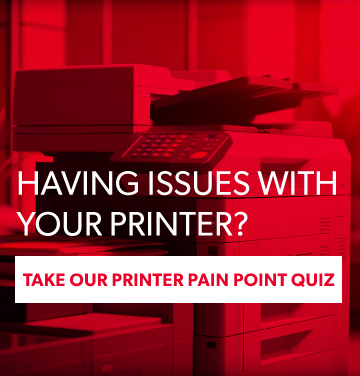Managed print services, delivered by the right service provider, can help save your business time and money. We sat down with Marisol Omand, HP North America Partner Marketing Manager, to answer some key questions about managed print programs. What is managed print services? Is a managed print program right for your organization? How do you pick the right supplier? Read on for the answers.
Beatties: What is managed print services?
Marisol: Managed print services, also known as MPS, helps businesses simplify owning, supporting and managing printer fleets. Through a multiyear contract, an HP MPS partnership helps businesses acquire the multifunction printers, supplies and support services needed to keep their businesses running efficiently. These services can also include software and security solutions that work with the multifunction printers. With an MPS agreement, the IT team can better predict costs, increase uptime, enhance security, deliver on end-user needs and scale the print environment as their workplaces continue to evolve. By freeing up internal IT resources, MPS enables the team to better focus on strategic initiatives and more directly contribute to the business. We like to say that managed print services can help you reduce costs and free up your time so you can do what you do best, even better.
Beatties: What kind of company is a good fit for managed print services?
Marisol: Any kind of business, from financial services to manufacturing, can benefit from managed print services. I find the best candidates are usually businesses that tend to use their printers or copiers to print something as part of their day-to-day business operations. In terms of company size, ideally it will be companies with at least 50 printers and more than 150 people.
Beatties: What are the financial benefits of managed print services?
Marisol: Businesses today are demanding predictability and most IT departments must tie their investments to business results. Managed print services gives a company extensive data access and visibility of the entire printing fleet, down to device-level data around supplies, usage, service repairs and status. Predictive data and proactive service minimize downtime and service calls. Adopting an HP MPS solution can help lower your cost of printing in several ways, including optimizing the number and type of printers, deploying fewer support interventions, and using less paper, toner and ink because of better print management.
Beatties: How does a managed print program address security issues?
Marisol: Security is very much top of mind for a lot of businesses. Cybercrime, internal breaches, compliance infringement and more can hurt your business. Your network firewall isn’t enough to protect your endpoints (or printing devices). HP Secure MPS provides three levels of security: device security, data security and document security. HP printers provide device security by stopping an attack the moment it starts. HP Enterprise models can even self-heal with unique security features. Data security is about protecting sensitive information—in transit and in the queue. The last level of security, document security, refers to solutions we offer that allow companies to protect confidential documents and reduce unclaimed prints. With HP Secure MPS, we help companies build layers of defense from the inside out, based on overall security best practices. We can help companies deploy a customized strategy to secure data and documents, monitor for threats, and maintain your print security over time.
Beatties: Does the data collector used by managed print services providers pose any security concerns?
Marisol: The data collector, which is installed on the company’s server, simply measures the number of pages that are printed. This gives the managed print services provider a picture of what the fleet looks like so it can make recommendations at the start of the program and continuously improve the performance of the fleet during the course of the contract. The data collector is just a dumb chip. It doesn’t read the content—it doesn’t know that the CFO just printed the salary list, but it will make sure the toner automatically arrives before it runs out.
Beatties: How does managed print services help with productivity?
Marisol: Productivity is imperative to successful operations. With multiple end users connecting to devices, printing devices need to run without malfunctioning in order to avoid disrupting workflows and accruing excess costs and maintenance needs. A large factor in your company’s overall efficiency is your internal print processes. Unclear processes can lead to wasted paper and multiple single-sided print jobs that go unclaimed and left stacked on company printers. With a managed print services program, we can review your processes and workflows and make recommendations to help your business operate at peak efficiency. Most document costs are not in the infrastructure and management of printing devices, but rather in how people manage, share and store documents within organizations, as well as between organizations and their customers and suppliers.
Beatties: What should a company look for when selecting a managed print services provider?
Marisol: A good managed print services provider is a strategic partner, not an order taker. I would use these seven questions as a guide to helping you evaluate the right provider for you.
- Are the services scalable and adaptable to future growth?
- Will these services help cut costs?
- Do these services and solutions meet relevant industry and government regulations?
- Will your network be protected and your sensitive data secured?
- Do these services create redundancies in-house, or will they free up your IT team to work more strategically?
- Will these services help streamline business processes?
- Are analytics included that will help you improve transparency and control costs?
Beatties: What are the steps to implementing a managed print services program?
Marisol: As you can probably gather by now, managed print services is a journey not a destination. The first step is to engage in a strategic conversation with a managed print services professional. In this meeting, we’ll discuss the print management needs of your company with those people in the organization who are responsible for printing. The next step is an assessment of your print environment, which means documenting your current print fleet. This includes what printers you have, where those printers are, and how many pages are printed. Collecting this information is critical for proposal development, and serves as the springboard for recognizing cost savings and improved efficiencies. The next important step is to document the actual spend for supplies, parts and consumables. With these important pieces of information, we can prepare a compelling proposal comparing the current costs of supporting each device with the MPS offerings available to you, showing the potential savings an MPS program can bring. By following this approach, HP—in partnership with a service provider like Beatties—will become your trusted long-term print advisor.
Experience the benefits of a managed print services partnership first-hand with a free 90-day trial of HP’s program, offered by Beatties.





